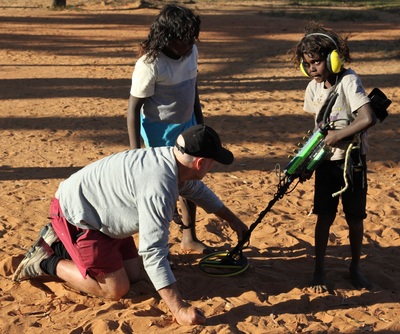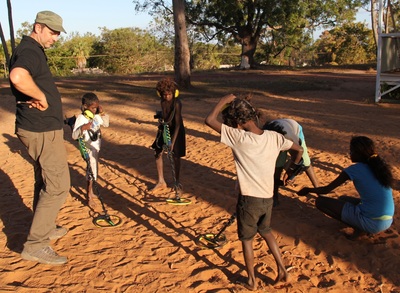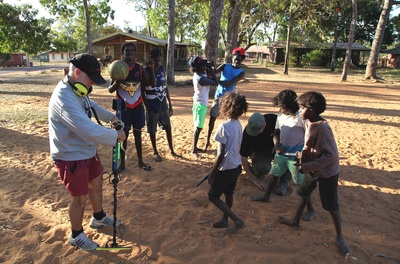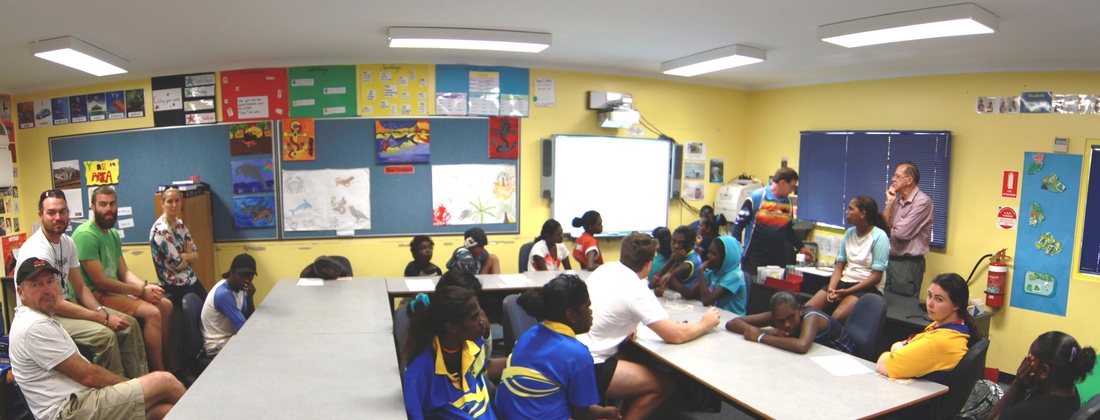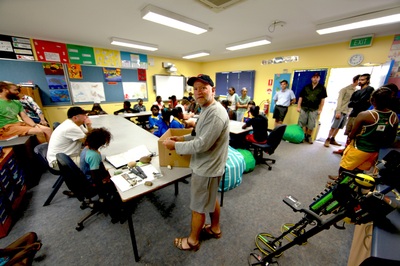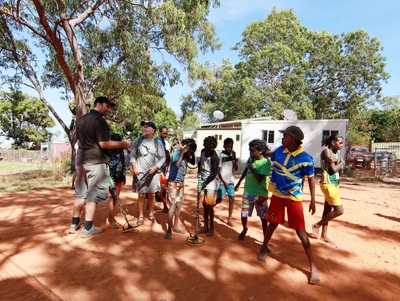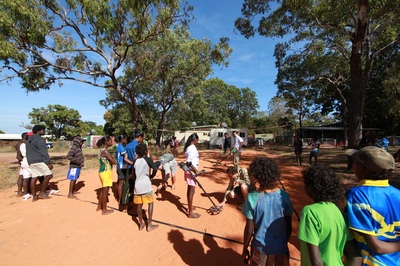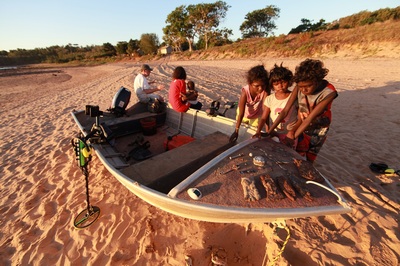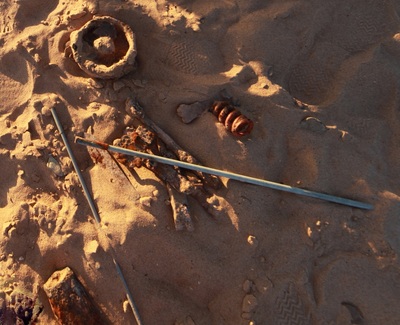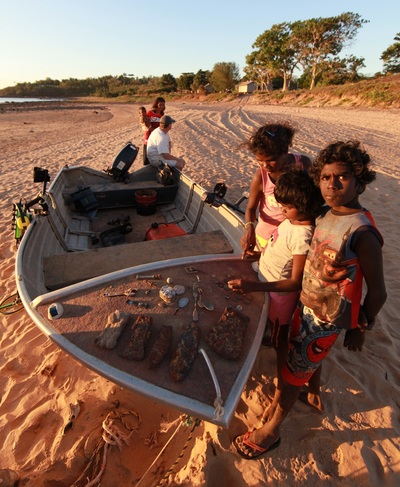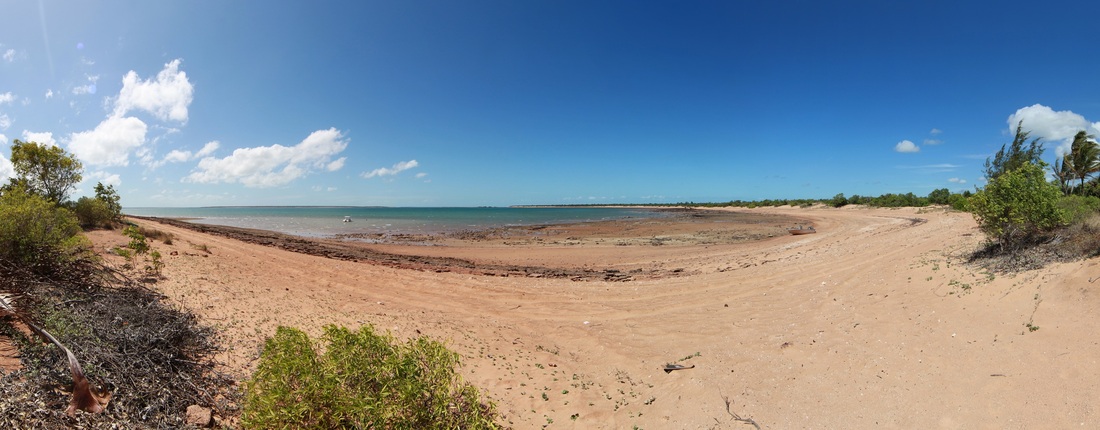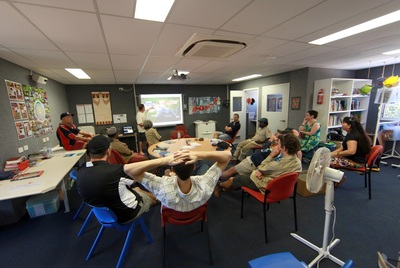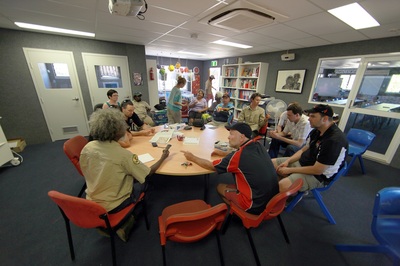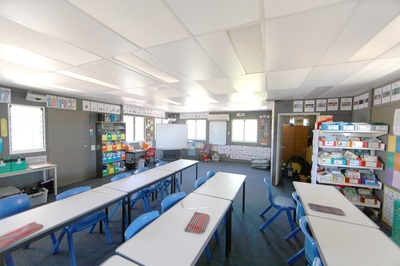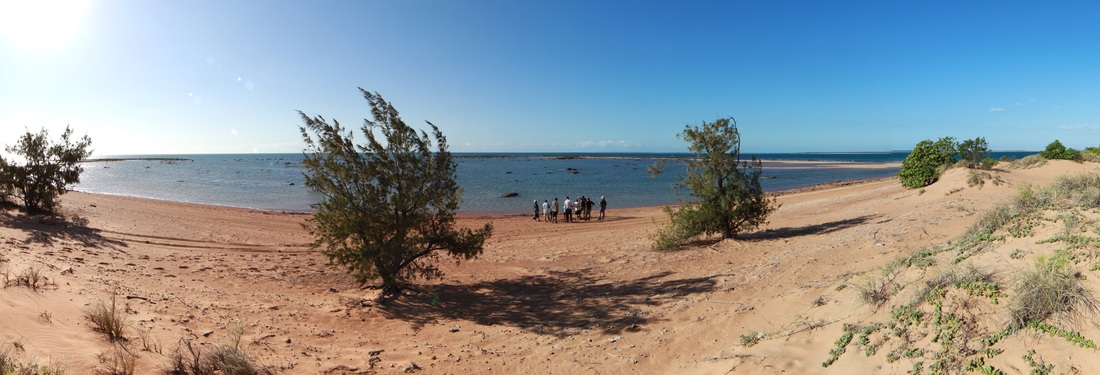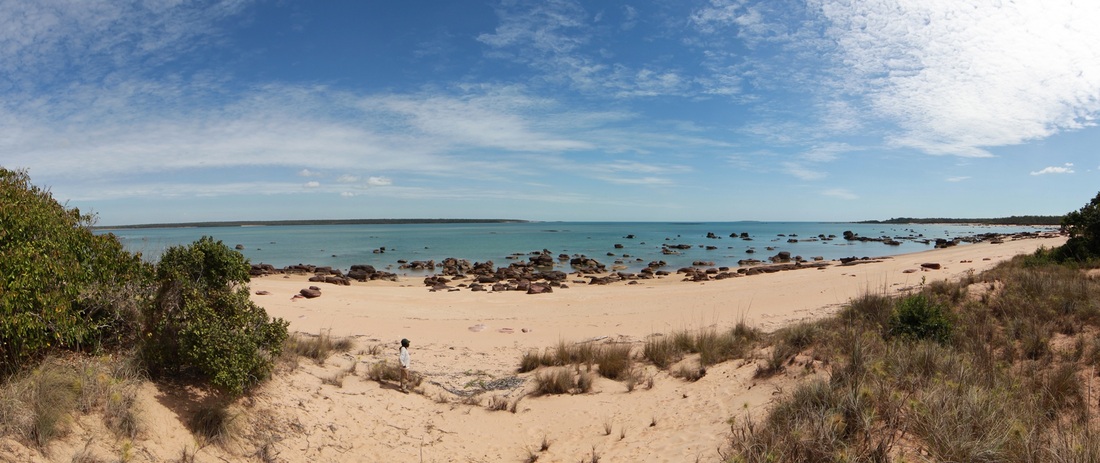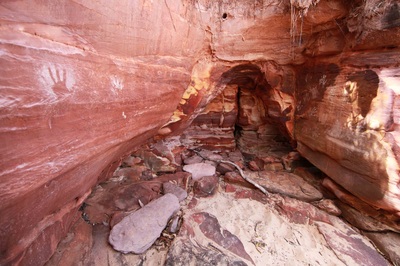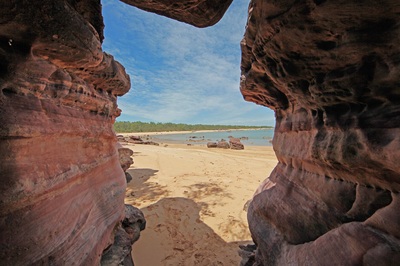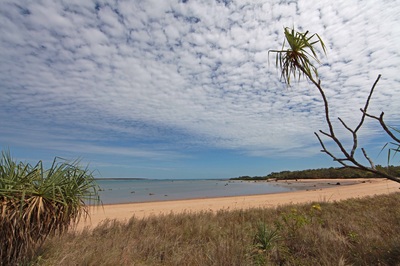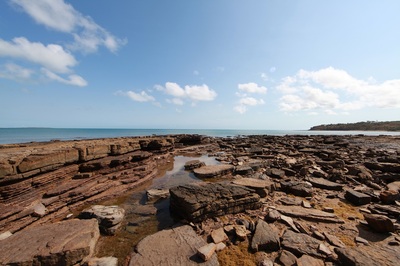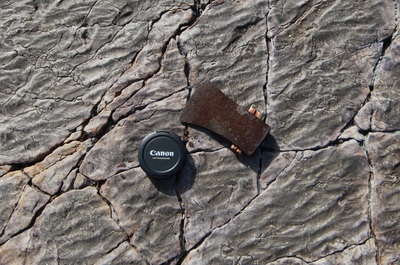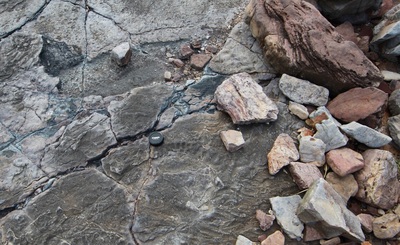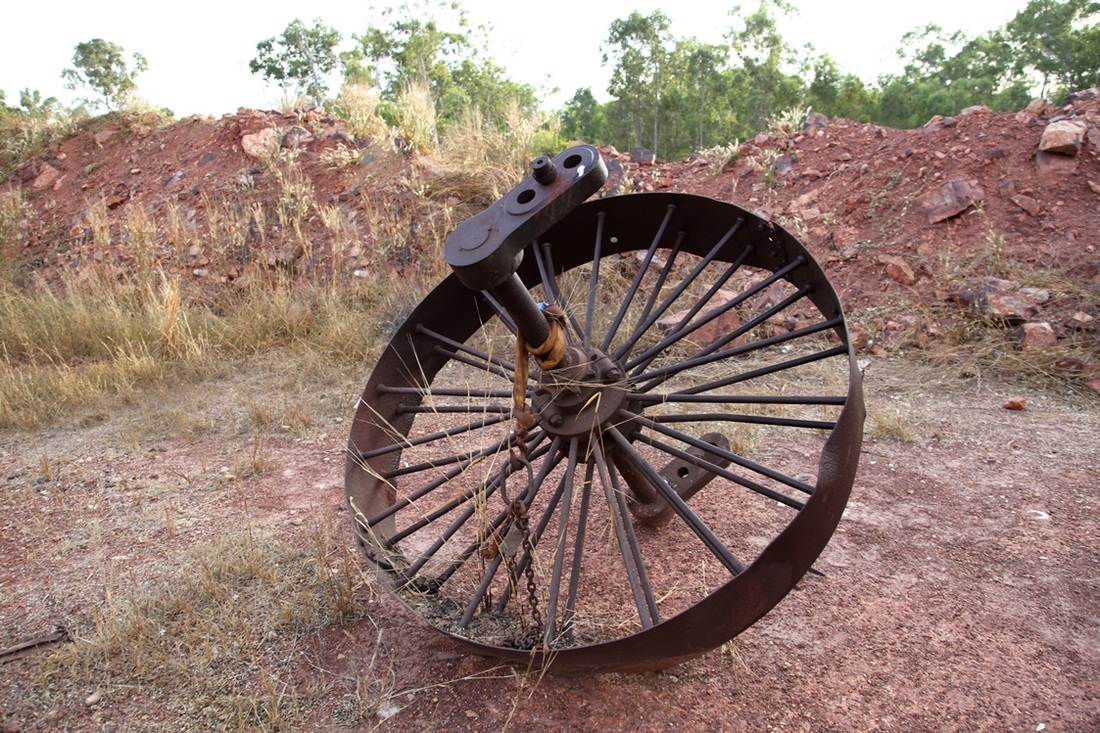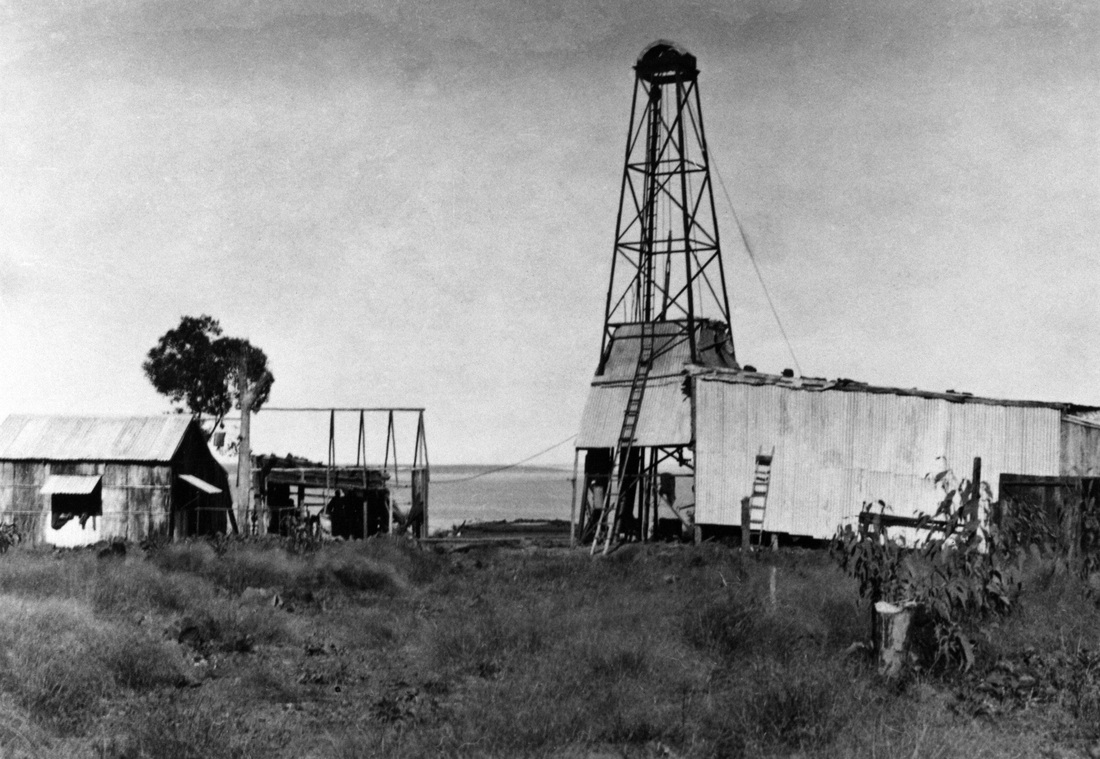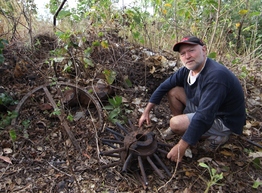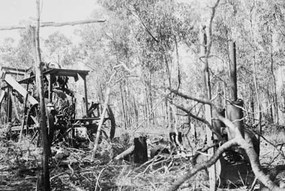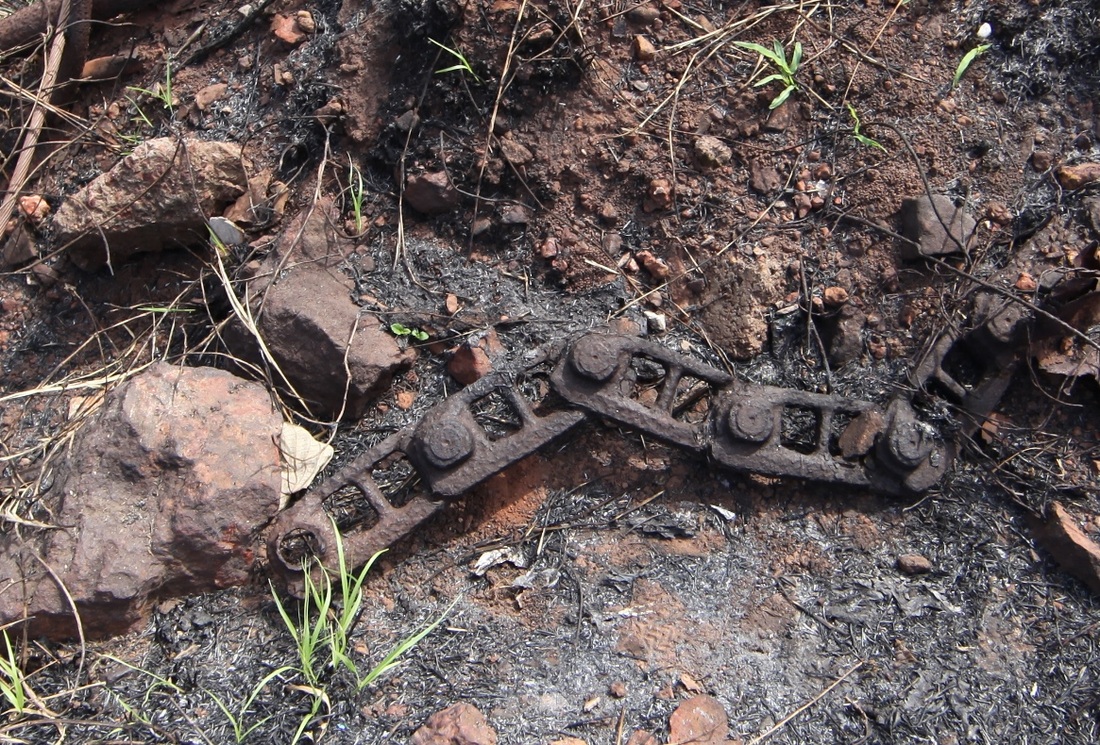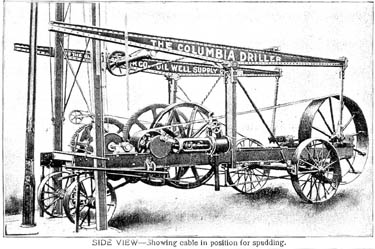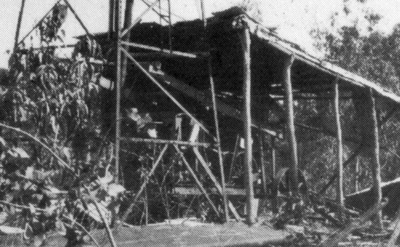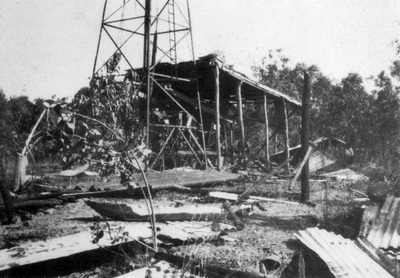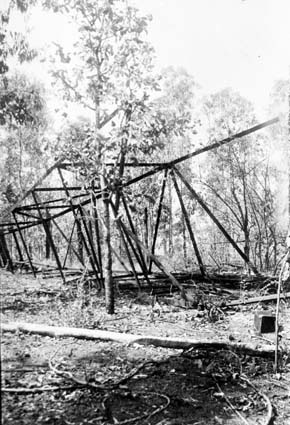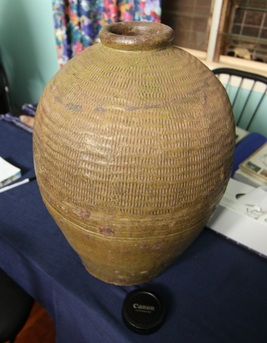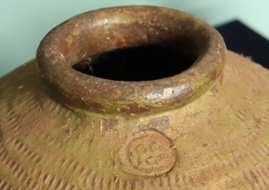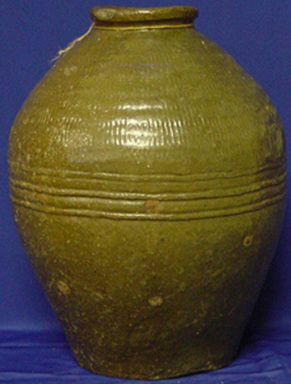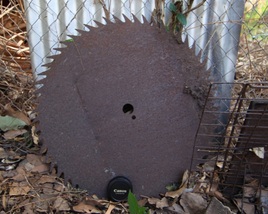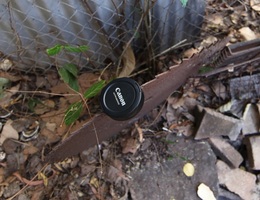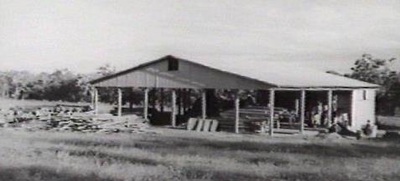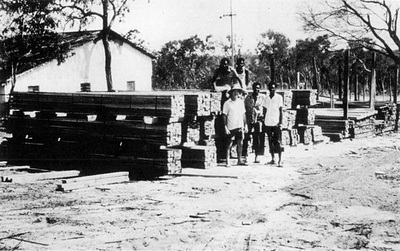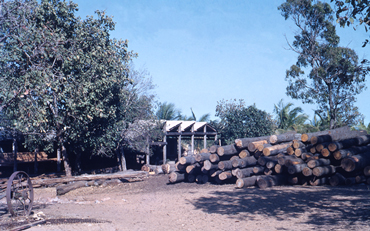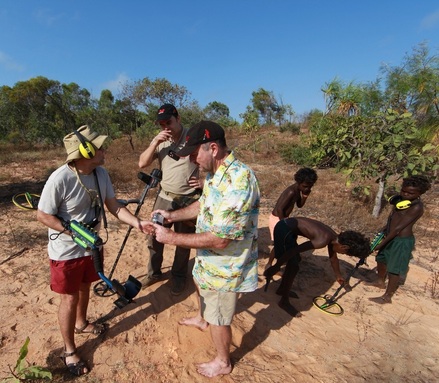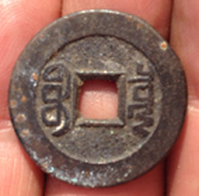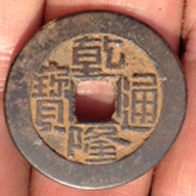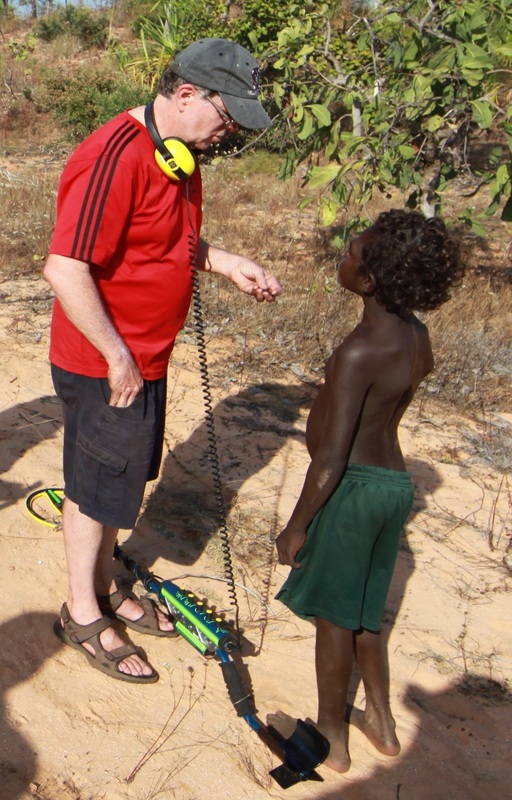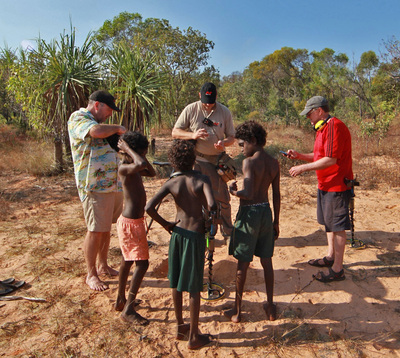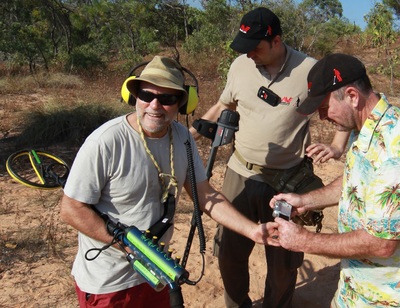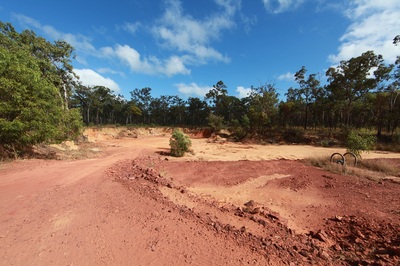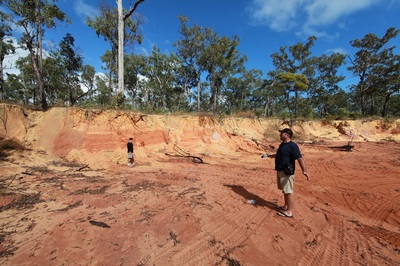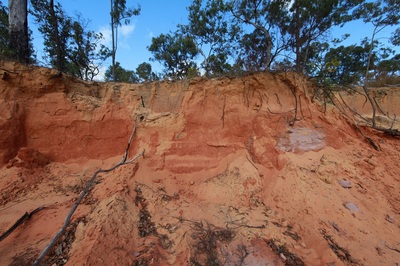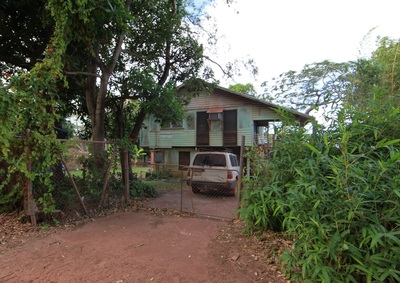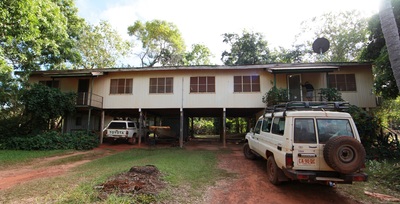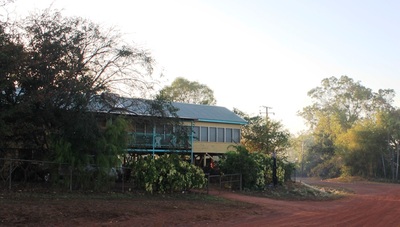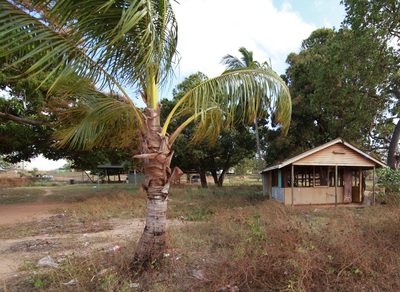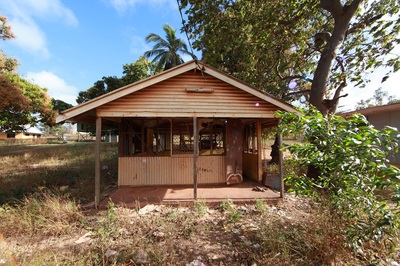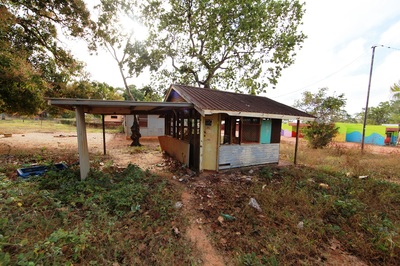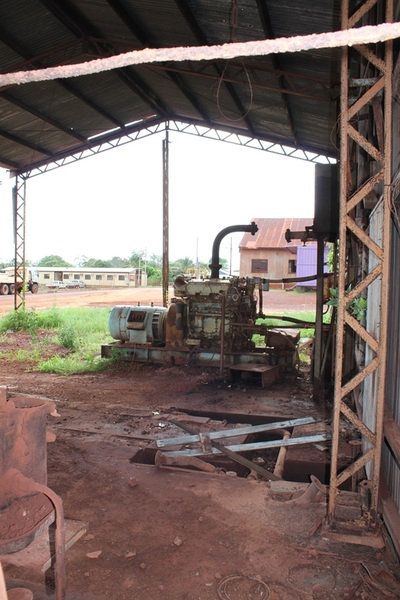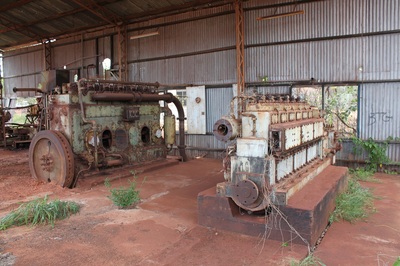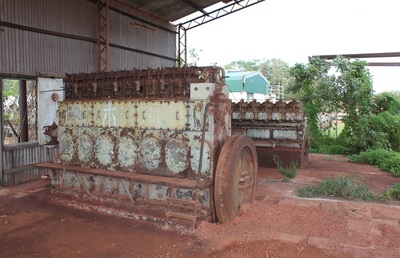Elcho Island - Past Muster 2014
Workshops - Demonstrations - Finds & Losses
Objectives
The principal objective was, as ever, engagement with the community. Every group, clan, family, senior person and traditional owner was tracked down and long acquaintance renewed with Ian McIntosh & other members who have spent time on or around the island. Heritage is the rolling stock of engagement and it was marshalled in workshops, a handling collection of artefacts, hands-on metal detection demonstrations, BBQ's and group presentations. Private sessions, dealing with particularly sensitive issues, were conducted with key individuals for whom the preservation and passing on of the clan's historical record is a defining role, responsibility & pleasure - as in any developed culture. There is now an imperative to capture as much heritage as possible - to find new ways & opportunities for teaching young people now that the lifelong study of cultural ways is no longer as prevalent as in the past. Hence the question - 'How much History and Heritage can we muster in five days?' - Quite a bit as it turned out.
Proposition:- Heritage Tourism Potential - Real or Imagined?
The image above imagines a cruise ship moored in Mission Bay, ready to ferry passengers ashore, eager to meet real Aboriginal people & glimpse their lives. There are no great civic buildings, no castles or cathedrals - no statues to commemorate local heroes like the Shepherdsons or disasters like the loss of the HMAS Patricia Cam & beheading of Rev. Kentish - nothing to break the ice & frame the photographs. So what would these eager tourists do, where would they go, what would they see and what could they hear of the history of Elcho Island. The Past Muster rescued & raised some impressive relics and the following brief history begins the process of weaving the narrative around them.
Heritage Workshops & Demonstrations
The first MD {metal detection} demonstration activity was held between the church and the old Council buildings. The idea was to seed the ground with loose change and see if the kids could work with the metal detectors and pin-pointers for reward. Kids on their way home from the store and young people on their way to footy training took it in turns with the equipment, under the tutelage of Nenad Lonic & Michael Hermes who taught at Lake Evella & on Groote Eylandt. In the end the kids found over $30 in currency as well as a few early decimal copper coins (1966) with which we became all too familiar.
Shepherdson College - Learning on Country Program
Gawa Outstation and Christian School
The South East
The Elcho Island Naphtha Petroleum Company Mine
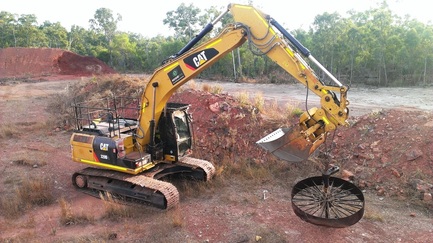
Margaret mentioned that some years ago she had seen the wheel from the old mine out at the dump. Why anyone would trouble to move it that far is a mystery but fortunately she was able to take us to the spot where Shane Marshall of the Regional Council saved this important relic from being buried in the remodelling of the dump.
This was the first oil drilling operation in Arnhem Land - without the Elcho Island Naphtha Petroleum Company there would have been no Milingimbi Mission, no Ramingining, the WWII base would've been at Elcho - which in turn would've been bombed - civilians evacuated to perhaps the mainland. With most of Arnhem Land depopulated, there have been little point in continuing the mainland Arnhem Land Reserve just for Oenpelli & Yirrkala.
After the flight of the wheel, we moved back to the mine site above the clinic and recovered some other pieces of mining machinery. In 1923 the mine had "an up to date boring plant - with a 45ft. steel derrick, capable of drilling to a depth of two thousand feet, driven by an oil engine, also a caterpillar tractor, oil driven and a trolley for the haulage of the plant and stores" shipped x-Brisbane on the Montoro to Darwin & on the company boat 'The Pat' to Elcho. Perhaps something like a Columbia Driller but with an external engine.
This was the first oil drilling operation in Arnhem Land - without the Elcho Island Naphtha Petroleum Company there would have been no Milingimbi Mission, no Ramingining, the WWII base would've been at Elcho - which in turn would've been bombed - civilians evacuated to perhaps the mainland. With most of Arnhem Land depopulated, there have been little point in continuing the mainland Arnhem Land Reserve just for Oenpelli & Yirrkala.
After the flight of the wheel, we moved back to the mine site above the clinic and recovered some other pieces of mining machinery. In 1923 the mine had "an up to date boring plant - with a 45ft. steel derrick, capable of drilling to a depth of two thousand feet, driven by an oil engine, also a caterpillar tractor, oil driven and a trolley for the haulage of the plant and stores" shipped x-Brisbane on the Montoro to Darwin & on the company boat 'The Pat' to Elcho. Perhaps something like a Columbia Driller but with an external engine.
More Margaret Miller Finds
Chinese Coin
The coin is unique in being the only Chinese one found in the vicinity of a reputed Macassan trepang processing site - Takkarena in Makassarese meaning Music Room. The name specifically describes the spring & the area immediately behind it where the old mission started and where Marthakal has its buildings today. Macassan trepangers, Naphtha oil drillers, Government vessels, Japanese pearlers, itinerant beachcombers, Constable Stokes, RAN vessels, post-war Mission windmill bore, Galiwin'ku Seafoods Pty Ltd and countless generations of Yolngu have drawn water from this spring. Missionary Harold Shepherdson had three Dutch VOC coins that were reportedly found on Mission Beach and whilst the location of the trepang processing site was reported by Burrumarra as having been further south, no trace of it could not be located by C.C. Macknight in 1967. The complete absence of mangrove fuel is curious - it may have been cut in Cadell Strait or behind Howard Is. & shipped over. We did not detect any substantial burning only campfire hearths. However, the pattern of a trepang industrial site distributed within a discrete orbit of resources and defensible positions is becoming more evident and explains anomalies at Milingimbi and Melville Island.
|
Finder: Nenad Lonic of Phase Technical was funded by Minelab as our principal metal detection trainer and exponent. We are working on protocols and procedures for MD archaeological surveys of littoral sites.
|
Description: Past Master Peter Lane - Qing Dynasty - Qiang Long emperor (1735-1796), cast at
a Beijing Mint.
An example of this coin appears in Standard
Catalog [sic] of World Coins 1701-1800, 4th Edition, see page 125
type A-2, minted at Boo-Clowan (Peking) by the Board of Revenue. Chien-Lung
T’ung–pao.
Is this the oldest Chinese coin found in Australia in an archaeological sense? No, but it is not really the right question. Chinese ‘cash’ coins, unlike western coins, generally had a long useable life span. Cash coins were mainly used outside China as lucky charms/gambling chits. I believe we can say it arrived in Australia no earlier that 1736 (a year after its possible mint date) and probably before 1907.
Description: Professor Tiequan Zhu of Sun Yat-Sen University in Guangzhou has also identified the copper alloy {brass} coin as being from the Qing Dynasty and made during the reign of the Emperor Qianlong (1736-1795 AD). Two Manchurian characters on one side of the coin indicate that it was minted at the Chinese Central Government’s coin manufacturing factory at Baoquan in Beijing.
Re-deposition: Upon the advice of our archaeologists, the coin was carefully returned to the ground after being photographed. It had been located with a Minelab Pin-pointer unit so that there was minimal disturbance of the shallow location. The Minelab 3030 metal detector records the GPS location & a numerical signature of the coin's composition to enable other items to be screened out & to simplify any attempted recovery. The Past Masters seek to enhance, not diminish, the history & heritage of Arnhem Land - our policy is that all finds belong to the indivisible entity that is the land & the people, as represented by the Traditional Owners. As yet, there are no museums or research facilities in Arnhem Land - the coin could not even be professionally photographed at the Darwin Museum and there is not a single XRF machine in the NT, despite the extensive mining industry and Centre of Excellence. Perhaps one day school children will visit their own community museum to stand before these solid tokens that speak of the island's history, when all other voices of those days have fallen silent. Some of the children may grow up to research & curate the collections whilst others become historians, archaeologists, history teachers and tour guides, weaving the strands of history and culture to the proud delight of future generations and international visitors alike - but not today. Dr. Ian McIntosh is sourcing examples of the coin for presentation to the school and traditional owners, these will be marked to obviate future excitement.
Conclusion: The coin was in good condition, of comparatively recent manufacture, so if lost by an impoverished Macassan trepanger, it would likely have had value in a world where even Dutch Doits were forged. If they did bring cash coins as gifts, tokens or fishing weights, they would perhaps have brought old, worthless ones. All we actually demonstrated was that the hitherto complete absence of Chinese coins reflects the absence of metal detectors & casual finds management, amid the general dearth of archaeological fieldwork in the Arnhem Land. More intense weather events would create great opportunities for identifying sites of historical importance - without local Rangers trained to recognised and mange these windfalls - they and their potential value will be lost forever.
Is this the oldest Chinese coin found in Australia in an archaeological sense? No, but it is not really the right question. Chinese ‘cash’ coins, unlike western coins, generally had a long useable life span. Cash coins were mainly used outside China as lucky charms/gambling chits. I believe we can say it arrived in Australia no earlier that 1736 (a year after its possible mint date) and probably before 1907.
Description: Professor Tiequan Zhu of Sun Yat-Sen University in Guangzhou has also identified the copper alloy {brass} coin as being from the Qing Dynasty and made during the reign of the Emperor Qianlong (1736-1795 AD). Two Manchurian characters on one side of the coin indicate that it was minted at the Chinese Central Government’s coin manufacturing factory at Baoquan in Beijing.
Re-deposition: Upon the advice of our archaeologists, the coin was carefully returned to the ground after being photographed. It had been located with a Minelab Pin-pointer unit so that there was minimal disturbance of the shallow location. The Minelab 3030 metal detector records the GPS location & a numerical signature of the coin's composition to enable other items to be screened out & to simplify any attempted recovery. The Past Masters seek to enhance, not diminish, the history & heritage of Arnhem Land - our policy is that all finds belong to the indivisible entity that is the land & the people, as represented by the Traditional Owners. As yet, there are no museums or research facilities in Arnhem Land - the coin could not even be professionally photographed at the Darwin Museum and there is not a single XRF machine in the NT, despite the extensive mining industry and Centre of Excellence. Perhaps one day school children will visit their own community museum to stand before these solid tokens that speak of the island's history, when all other voices of those days have fallen silent. Some of the children may grow up to research & curate the collections whilst others become historians, archaeologists, history teachers and tour guides, weaving the strands of history and culture to the proud delight of future generations and international visitors alike - but not today. Dr. Ian McIntosh is sourcing examples of the coin for presentation to the school and traditional owners, these will be marked to obviate future excitement.
Conclusion: The coin was in good condition, of comparatively recent manufacture, so if lost by an impoverished Macassan trepanger, it would likely have had value in a world where even Dutch Doits were forged. If they did bring cash coins as gifts, tokens or fishing weights, they would perhaps have brought old, worthless ones. All we actually demonstrated was that the hitherto complete absence of Chinese coins reflects the absence of metal detectors & casual finds management, amid the general dearth of archaeological fieldwork in the Arnhem Land. More intense weather events would create great opportunities for identifying sites of historical importance - without local Rangers trained to recognised and mange these windfalls - they and their potential value will be lost forever.
Journal of the Numismatic Association of Australia volume 25 2014
The discovery of an eighteenth century Chinese cash coin on Elcho Island, Northern Territory
Michael Hermes, Peter Lane, Nenad Lonic, Ian McIntosh
Abstract
An eighteenth century Chinese cash coin was recently found on a remote Northern Territory island east of Darwin during a heritage training workshop. Whereas most finds of this type of coin in Australia are associated with Chinese gold mining communities, the location of this find suggests it is associated with the Macassan trade, which for at least 150 years brought people from modern day Indonesia to collect trepang and trade with the Indigenous communities across northern Australia. The paper also touches upon the role of metal detection technology in cultural heritage studies in Australia.
The discovery of an eighteenth century Chinese cash coin on Elcho Island, Northern Territory
Michael Hermes, Peter Lane, Nenad Lonic, Ian McIntosh
Abstract
An eighteenth century Chinese cash coin was recently found on a remote Northern Territory island east of Darwin during a heritage training workshop. Whereas most finds of this type of coin in Australia are associated with Chinese gold mining communities, the location of this find suggests it is associated with the Macassan trade, which for at least 150 years brought people from modern day Indonesia to collect trepang and trade with the Indigenous communities across northern Australia. The paper also touches upon the role of metal detection technology in cultural heritage studies in Australia.
| the_discovery_of_an_eighteenth_century_chinese_cash_coin_on_elcho_island_northern_territory.pdf | |
| File Size: | 456 kb |
| File Type: | |
|
|
| ||||||||||||
Pleistocene Dunes
(Above), this sand quarry is behind the main Galiwin'ku community, on the backtrack between the barge landing road and the airstrip. Tim Stone does ranging pole duties in front of a seam of fine red Pleistocene sand which is the remains of east/west Simpson Desert sand dunes that, at the height of the cool dry Ice Age 20,000 years ago, stretched from northern Tasmania into southern New Guinea. Tim first suspected the existence of these dunes when he flew over Arnhem Land to visit Ian McIntosh on Elcho Island a quarter of a century ago. The red 'builders' sand is very fine and much prized in the construction industry. It is remarkable that the land has changed so dramatically in such a comparatively short time and yet it is barely discernible in the landscape. Hopefully, this site will figure prominently in future field trips of Shepherdson College.
Mission Era Buildings
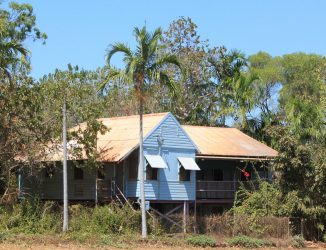 Harold & Elizabeth Guy's dream house 1950
Harold & Elizabeth Guy's dream house 1950
Peter Forrest's 1990 Survey of Methodist Mission
Heritage Sites recommended that the creation of a Mission Heritage Precinct on Elcho would cover "the historic area between the present church, the seafront and Shepherdson College". Forrest recommended that the precinct be recommended to the Register of the National Estate, as it covered the period 1942 to 1972 'evoking the mission years...its carefully considered buildings contrast sharply with much of the later profligate and unsuitable building in the post 1972 period'.
It had been intended to use Forrest's data as the baseline for a study but almost every building in the old mission area has been destroyed. There are a few houses going up the hill including this blue 1953 Guy's House which is occupied by ARDS and requires re-stumping. The buildings should be listed and protected if there is anything to remind future generations of the 'old days' when their ancestors cut & floated the Cypress logs, milled the timber, built houses, sheds and boats which they skippered and crewed for their Galiwin'ku Seafoods Pty Ltd business - whilst the frames and offal fertilised the market gardens and improved the pasture for goats and cattle. A proud and productive time that has been systematically culled from history by succeeding Government administrations embarrassed by the unavoidable comparisons.
The new NT Heritage Act is more robust than the old one {e.g. Bapa Sheppy’s House - nominated in 1999 - burned down in 2011, whilst still in the Consultation Period}- however, NT Heritage Registration remains problematic. Recent losses of the timber mill and workshops have shown that if any heritage capital is to be preserved - the community must be empowered to identify, document, register & fix plaques to buildings to notify contractors - alert visitors & new staff to the protected status & significance. Especially in remote areas, heritage protection must be predominantly a local authority responsibility. The following images show some of the remaining heritage assets from the Mission days - these desirable sites have breeze & views. They are also mini museums where relics are gathered & inherited by successive balanda staff.
It had been intended to use Forrest's data as the baseline for a study but almost every building in the old mission area has been destroyed. There are a few houses going up the hill including this blue 1953 Guy's House which is occupied by ARDS and requires re-stumping. The buildings should be listed and protected if there is anything to remind future generations of the 'old days' when their ancestors cut & floated the Cypress logs, milled the timber, built houses, sheds and boats which they skippered and crewed for their Galiwin'ku Seafoods Pty Ltd business - whilst the frames and offal fertilised the market gardens and improved the pasture for goats and cattle. A proud and productive time that has been systematically culled from history by succeeding Government administrations embarrassed by the unavoidable comparisons.
The new NT Heritage Act is more robust than the old one {e.g. Bapa Sheppy’s House - nominated in 1999 - burned down in 2011, whilst still in the Consultation Period}- however, NT Heritage Registration remains problematic. Recent losses of the timber mill and workshops have shown that if any heritage capital is to be preserved - the community must be empowered to identify, document, register & fix plaques to buildings to notify contractors - alert visitors & new staff to the protected status & significance. Especially in remote areas, heritage protection must be predominantly a local authority responsibility. The following images show some of the remaining heritage assets from the Mission days - these desirable sites have breeze & views. They are also mini museums where relics are gathered & inherited by successive balanda staff.
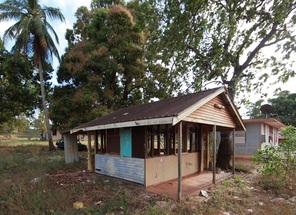
Mission Housing
This is the last cottage of its type. It was probably built in the 1960's or early 70's by local builders, from Cypress pine which was locally sourced & milled. The majority of Cypress coming from the Lake Evella area from the mid-sixties onwards.
The Local Authority has expressed a strong desire to retain this old dwelling and the stages of housing development are an important reminder of progress per see. Additionally, these buildings are an important reminder of achievements of Yolngu builders & loggers prior to Government control 1972. The building was photographed in detail so could be reconstructed in the future - its chances of survival are negligible. Remote town planning is determined by proximity to sewerage lines. Relocation to an outstation is an option though there are many obstacles.
This is the last cottage of its type. It was probably built in the 1960's or early 70's by local builders, from Cypress pine which was locally sourced & milled. The majority of Cypress coming from the Lake Evella area from the mid-sixties onwards.
The Local Authority has expressed a strong desire to retain this old dwelling and the stages of housing development are an important reminder of progress per see. Additionally, these buildings are an important reminder of achievements of Yolngu builders & loggers prior to Government control 1972. The building was photographed in detail so could be reconstructed in the future - its chances of survival are negligible. Remote town planning is determined by proximity to sewerage lines. Relocation to an outstation is an option though there are many obstacles.
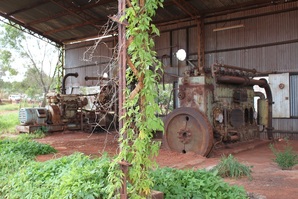
Powerhouse
The Local Authority is most anxious to preserve the powerhouse and it has been excised from a town lot created under the Intervention which nearly saw it destroyed. The level of destruction and total disregard for community heritage is echoed in the comprehensive absence of any archaeological site clearance before construction despite clear evidence of a continuity of Yolngu occupation going back many centuries - if not millennia.
Shane Marshall from the Regional Council is keeping a close eye on the place to ensure its survival - he is working to secure materials to strengthen & protect the building. Footage has just been found of Ralph Blyth's father & crew installing the generator (far left). Ralph is a past president of West Arnhem Shire, a history buff & knowledgeable about the hay days of the missions.
The Local Authority is most anxious to preserve the powerhouse and it has been excised from a town lot created under the Intervention which nearly saw it destroyed. The level of destruction and total disregard for community heritage is echoed in the comprehensive absence of any archaeological site clearance before construction despite clear evidence of a continuity of Yolngu occupation going back many centuries - if not millennia.
Shane Marshall from the Regional Council is keeping a close eye on the place to ensure its survival - he is working to secure materials to strengthen & protect the building. Footage has just been found of Ralph Blyth's father & crew installing the generator (far left). Ralph is a past president of West Arnhem Shire, a history buff & knowledgeable about the hay days of the missions.
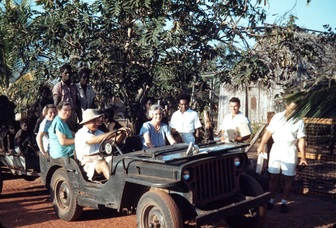
Roll Call of Mission Staff
The objective would be to record the significant Yolngu, Fijian & Balanda mission personnel and to identify them in images such as this NTL PH0236-0055 taken in 1952 from the Colin Gill collection. Shepherdsons, Guys, Gullicks & goodness knows who else????? - Margaret Miller advises that there is a book listing personnel against housing and images in many collections.
Harolds, Shepherdson & Guy, were both engineers who passed their knowledge onto significant identities who became the carpenters, builders, agriculturalists and foremen of every trade imaginable. Sheppy came from a family with a long history of logging and timber milling and particular effort will go towards documenting individuals along with the buildings & boats that they constructed. Elcho Island was the hub of post-war mission work in East Arnhem so that the net would be cast over Lake Evella and Yirrkala to complete the list of local high achievers.
The objective would be to record the significant Yolngu, Fijian & Balanda mission personnel and to identify them in images such as this NTL PH0236-0055 taken in 1952 from the Colin Gill collection. Shepherdsons, Guys, Gullicks & goodness knows who else????? - Margaret Miller advises that there is a book listing personnel against housing and images in many collections.
Harolds, Shepherdson & Guy, were both engineers who passed their knowledge onto significant identities who became the carpenters, builders, agriculturalists and foremen of every trade imaginable. Sheppy came from a family with a long history of logging and timber milling and particular effort will go towards documenting individuals along with the buildings & boats that they constructed. Elcho Island was the hub of post-war mission work in East Arnhem so that the net would be cast over Lake Evella and Yirrkala to complete the list of local high achievers.





